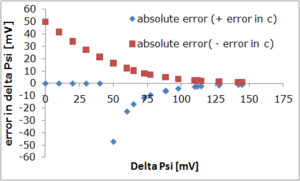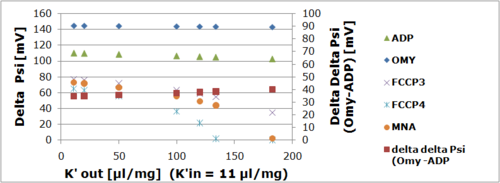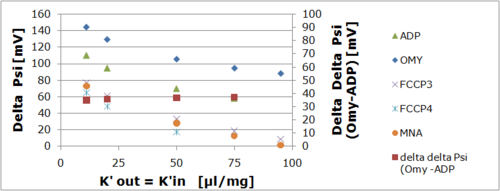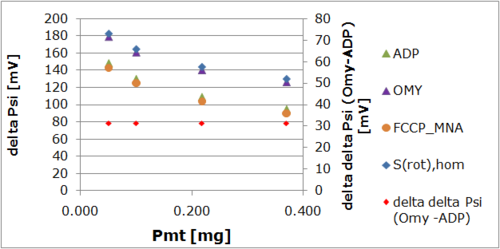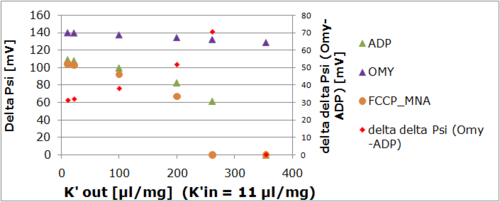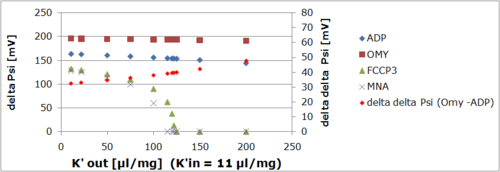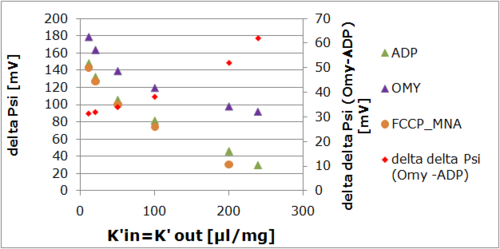From Bioblast
Description
Tetraphenylphosphonium (TPP+). A lipophilic molecular probe in conjunction with an ion selective electrode (ISE) for measuring the mitochondrial membrane potential.
Abbreviation: TPP+
Reference: Mitochondrial membrane potential
Application in HRR
- TPP:Tetraphenylphosphonium chloride ; Sigma 218790, 5 g, store at room temperature; M = 374.84 g·mol-1
- Caution: Light sensitive.
- TPP:Tetraphenylphosphonium chloride ; Sigma 218790, 5 g, store at room temperature; M = 374.84 g·mol-1
- Preparation of 10 mM stock solution- Conditioning solution 1 (dissolved in 100 mM KCl solution) for use in 2-mL O2k-chamber:
- Prepare fresh everyday.
- Weigh 187.42 mg of TPP.
- Add 50 mL 100 mM KCl.
- Adjust pH to 7.0.
- Preparation of 1 µM stock solution- Conditioning solution 2 (dissolved in 100 mM KCl solution) for use in 2-mL O2k-chamber:
- 1 mM stock solution: Dilute 1 mL of 10 mM TPP stock solution with 9 mL 100 mM KCl solution.
- 100 µM stock solution: Dilute 1 mL of 1 mM TPP stock solution with 9 mL 100 mM KCl solution.
- 1 µM stock solution: Dilute 100 µL of 100 µM TPP stock solution with 9.9 mL 100 mM KCl solution.
- KCl:Potassium chloride; Sigma P3911, store at room temperature; M = 74.55 g·mol-1
- Preparation of 100 mM KCl stock solution (dissolved in H2O) for use in 2-mL O2k-chamber:
- Weigh 1.491 g of KCl.
- Add 200 mL dest H2O.
- Adjust pH to 7.0.
- -See: MiPNet15.08 TPP electrode
MitoPedia O2k and high-resolution respirometry:
O2k-Open Support
- The TPP+ inhibitory effect on respiration should be explored when applying TPP, and unspecific binding should be considered when calculating the mt-membrane potential: MiPNet15.08 TPP electrode.
O2k signal and output
- O2k signal: The O2k-TPP+ ISE-Module is operated through the pX channel of the O2k, with electric potential (volt [V]) as the primary and raw signal
- O2k output: type C
- In Series D and higher the ISE connectors consist of 2 ports:
- A BNC port: both poles are "live" so it can be used either for a combination electrode (like a classical pH) or for just one singe electrode that requires a separate reference electrode.
- A 2 mm pin type connection that is used for connecting the separate reference electrodes for TPP and pH.
- In Series D and higher the ISE connectors consist of 2 ports:
Standard cleaning procedure for TPP+ and reference electrodes
- The PVC membranes of the ISE are generally only suitable for operation in aqueous media and are damaged by non-aqueous solvents. Therefore, the necessary washing steps between experiments have to be carefully optimized according to specific experimental regimes.
- Rinse the electrodes after use with water, dry with paper, rinse with absolute ethanol, again dry with paper and rinse with water again.
- Store in a separate falcon tube with a proper storage solution.
- When inhibitors and uncouplers have been used, continue by putting the electrodes into a falcon tube filled with distiled water for 2-5 min. Then switch to the falcon tube with a warm (30-37°C)'biological cleaning sample' for 20-30 min. Liver homogenate, isolated mitochondria or cell cultures can be used as biological cleaning sample, which can be stored at -20°C.
- Alternatively, the electrodes can be washed with biological cleaning sample added to the O2k-chamber, cleaning the insterted electrodes and the O2k-chamber together.
- If a carry-over of inhibitors is observed despite of the above cleaning steps, immerse the TPP electrode in absolute ethanol for a few minutes in the O2k-chamber, with stirring. However, afterwards the electrodes have to be tested and a reduced lifetime for the membranes is to be expected.
- Discussion
TPP electrode - interaction with TMPD
- TMPD traveling into the TPP probe: pretty sure it was happening because the electrolyte was turning blue. And actually it became a persistent problem with several probes (at first I thought maybe there was a leak around the membrane off of one probe) (it would shift the absolute voltage values to more positive, until it the signal gets super staticky and I couldn't use the data at all). I resorted to either making sure I inverted the probe a few times to redistribute the TMPD in the electrolyte to spread it out a bit... or switching out the electrolyte (without replacing the membrane) and letting it sit overnight. And of course minimizing contact time of the probe with a solution containing TMPD.
- ~ Contribution by Gigi Lau from CA Vancouver Richards JG.
Mitochondrial membrane potential and anoxia
- Can anoxia be used as a reference state for zero (minimum) mt-membrane potential in isolated mitochondria? This might save the time for washing out inhibitors or uncouplers. The protocol includes substrates and ADP.
- Anoxia should provide a good reference value for minimum mt-membrane potential. However, you should carry out a test experiment: After reaching anoxia, add oligomycin as a test for the possibility that ATPsynthase acts as a ATPase and thus maintains a mt-membrane potential in reversed mode of operation. Then titrate uncoupler (FCCP) to collaps the mt-membrane potential under anoxia.
- Careful: Ethanol as a carrier for oligomycin and FCCP exerts a chemical side effect on the TPP+ signal, which has to be evaluated in a separate control experiment and subtracted from the experimental trace.
- Can anoxia be used as a reference state for zero (minimum) mt-membrane potential in isolated mitochondria? This might save the time for washing out inhibitors or uncouplers. The protocol includes substrates and ADP.
Correction for substance-specific effects on the TPP signal
- The necessity to perform a TPP chemical background experiment is explained in MiPNet 14.05. Some additional considerations:
When to apply a correction
- For isolated mitochondria absolute delta delta Psi values seem obtainable, see above. Approximate delta Psi values seem to be principally obtainable, though with relying on literature data. The strongly quantitative approach enabled thereby calls for complete quantifications including correction for unspecific effects.
- For permeabilized cells, homogenates, and permeabilized fibers, absolute values of delta or delta delta Psi seem currently difficult to obtain. Data will have to presented as a relative value. Therefore, a discussion about to apply or not to apply a correction for substance specific effects seems justified: Whenever changes of mitochondrial membrane potential during an experiment are of interest a correction is most definitely needed. Otherwise even the nature of the change (increase / decrease) may be misjudged.
- When membrane potentials obtained by different protocols but using the same parameters (binding correction factors) during calculation should be compared to each other, correction for substance specific effects has to be done, even though only relative values are compared to each other.
- When relative values for membrane potentials of the same state obtained via totally identical protocols are to be compared between different samples a correction may not be strictly necessary. In this case the research will have to judge on a case basis. If the correction is obviously rather difficult, the danger of introducing additional errors may be greater than any benefit from getting slightly more realistic values.
Substances
- Azide, N3-, has a very huge substance-specific effect. A correction does not seem feasible.
- The substance-specific effect of ADP is comparably large and should be considered carefully.
Mitochondrial membrane potential of permeabilized fibers
- Based on a report by Lin Chien-Te (Peter), Darrell Neufer at East Carolina University, Greenville, NC, USA and contributions by Mario Fasching and Zuzana Sumbalova.
General
- From experiments with isolated mitochondria or permeabilized cells one can derive the concentration and mitochondrial activity (oxygen flux per volume) necessary to obtain reliable signals with the TPP+ electrode. Since unspecific binding is higher om permeabilized muscle fibers compared to isolated mitochondria, the amount of fibers should be chosen to obtained rather high volume-specific oxygen fluxes. Even with permeabilized cells higher sample concentrations are required, as compared with standard high-resolution respiratory measurements. It is important that the total amount of TPP in the chamber is known at all times. Therefore, the sample should not be preconditioned outside of the chamber to TPP, and even a rough estimation of the sample volume will be necessary.
Introduction of the sample
- The established way to measure mitochondrial membrane potential for isolated mitochondria (and permeabilized cells) is to calibrate the TPP electrode by adding TPP in several steps to the experimental chamber. With the final calibration step the starting TPP+ concentration is reached. Then the sample is injected into the "calibrated" chamber. Therefore, unlike in the application of other potentiometric methods (pH, Ca2+,..) the "calibration" does in fact serve two different purposes:
- Calibration of the sensor;
- Establishing the total amount of TPP in the chamber. This amount has to be precisely known for calculation of mtMP from the measured [TPP+].
- The established way to measure mitochondrial membrane potential for isolated mitochondria (and permeabilized cells) is to calibrate the TPP electrode by adding TPP in several steps to the experimental chamber. With the final calibration step the starting TPP+ concentration is reached. Then the sample is injected into the "calibrated" chamber. Therefore, unlike in the application of other potentiometric methods (pH, Ca2+,..) the "calibration" does in fact serve two different purposes:
- Introduction of the sample is a key problem. Removing the stoppers and placing the permeabilized fiber into the chamber results in a disturbance of the TPP electrode calibration. It would be necessary to replace all medium lost with medium containing exactly the TPP concentration established in the O2k-chamber before opening it. However, after introducing permeabilized fibers they immediately start to take up TPP. Opening and closing the chamber typically requires quite a lot of “bubble fighting”.
- The recommended approach is:
- The TPP+ electrode is calibrated up to 1. 0 or 1.5 µM [TPP+] at a high O2 level of >500 µM.
- Lift the stopper with electrodes just slightly (stirrer off), such that the TPP+ electrode is still immersed in the Medium.
- Remove the reference electrode.
- Introduce fibers through reference electrode port using a glass Pasteur pipette cut to the length 16.2 cm. The cut edge was smoothed in a flame. The fibers are taken up into the pipette and gently introduced into the chamber.
- The wet weight is about 3 mg per chamber for mouse cardiac muscle.
- Close the chamber without bubbles and switch on the stirrers.
- Due to the high O2 flux frequent reoxygenations are required.
- The disturbance of the calibration by removing and re-inserting the reference electrode is minimal. Removal and reinsertion of the reference electrode should be done with stirrers switched off. The fiber bundles are split into several parts if necessary.
Reoxygenation and high oxygen
- The method recommended by Oroboros to do a re-oxygenation in the presence of additional electrodes is to inject H2O2 into a medium containing catalase, avoiding any mechanical disturbances, see the protocol for the MiR06 medium MiPNet14.13. Because the H2O2 method is limited to a delta cO2 of 200 µmol/L the initial high oxygen concentration should be achieved with high oxygen in the gas phase before starting the experiment. The O2 level can then be maintained by H2O2 injections without further opening the chamber.
Slowness of TPP uptake and release
- TPP uptake and release seems generally to be slower for permeabilzed fibers than for isolated mitochondria or permeabilized cells. However, the extent of this effect was reported to be very different by different groups. It is not yet clear what causes extremely slow uptake/ release in some cases but not in others.
Calculation of mitochondrial membrane potential from measurement of TPP+
- Based on information provided in the O2k-Protocols MiPNet 14.05, which should be consulted first.
- File:SUIT-006 TPP mt.xls
- File:SUIT-006 TPP mt demo.xls
- The calculation of mitochondrial membrane potential from measurements with a TPP electrode is a difficult and far from settled topic.
Sensitivity analysis of the method
- The sensitivity of the method to small errors is strongly dependent on the membrane potential. For low membrane potential the method is inherently unsuitable. This is illustrated by introducing an artificial errors in the measured TPP+ concentration and plotting the resulting errors in the calculated membrane potential against the (original) membrane potential. The exact shape of the function depends on sample amount and type, binding correction and all other external factors but the general shape is usually quite constant.
- Here this is illustrated for isolated (un-purified) mitochondria, simulating the effect of a +1% and -1% error in the measured TPP+ concentration.
- The used calculation template is not able to deal properly with results that would lead to a negative membrane potential, therefore errors leading to a 0 or negative membrane potential are shown here as "zero".
Unspecific binding
The four compartment model
- The approach to unspecific binding chosen in MiPNet 14.05 and in the Oroboros Spreadsheet temples is basically based on Rottenberg's [1] 4 compartment model, developed for isolated mitochondria. As shown in the mathematical appendix to MiPNet 14.05 this approach seems to be mathematically fundamentally equivalent to the approaches by Brand [2] and Kamo [3], at least for the processes inside the mitochondria.
- Four compartments are considered:
- The liquid filled matrix of the mitochondria, containing “free, internal” TPP+.
- Material (membranes etc ) exposed to the typically high TPP+ concentration in compartment A. In Rottenbergs original approach this is the inside face of the inner mitochondrial membrane.
- The liquid filled space outside the mitochondria. This comprises the entire volume of the sample chamber with the exception of compartments A, B, and D.
- Material (membranes etc) that are exposed to the typically low TPP+ concentrations outside the mitochondrial matrix. In Rottenberg's original approach this compartment comprises the outside face of the inner mitochondrial membrane and any present material from the outer mitochondrial membrane or traces of cell material not removed during purification.
- The probe ion is supposed to accumulate in compartments B and D directly proportional to
- the “size/amount” of the compartment, measured by some marker, e.g. protein content
- the concentration of probe molecule in the adjunct liquid phase, e.g the TPP+ concentration in the mitochondrial matrix
- a factor describing the affinity of the compartment to the probe molecule (the binding correction factor.
- The probe ion is supposed to accumulate in compartments B and D directly proportional to
- E.g., the amount of TPP+ "bound" by the inward facing side of the inner mitochondrial membrane is
- n(int,bound) = Ki' * Pmt * C(int,free)
- (Equation A8a in the mathematical Appendix to MiPNet14.05)
- A binding correction factor (e.g. Ki’) is only useful together with a certain type of marker (Pmt) for which it was determined.
- The approaches by Brand and Kamo do not consider the outside compartments for unspecific binding. Indeed, for purified isolated mitochondria the outside binding seems to have a very small effect. Therefore in all further considerations one has to discern between studies of purified isolated mitochondria and studies with other sample types.
Isolated mitochondria and unspecific binding in the mitochondria
- Due to the small amount of material exposed to the outside concentrations and the low outside concentrations only the inside binding is significant.
- The absolute values for delta Psi will depend on the chosen binding correction factors.
- The absolute DIFFERENCE between membrane potentials (either between different states or different samples) will NOT depend on the chosen inside binding correction factor, see MiPNet 14.05 Mathematical Appendix. Therefore, it should be possible to obtain absolute change of delta Psi’s for this sample type. The insensitivity against outside binging can be shown by varying the outside binding parameter only:
- Only a few binding correction factors for internal binding have been published, based on rat liver mitochondria or membrane models under very different conditions (temperatures, mitochondrial membrane potential,…) While different mathematical approaches were used to describe the binding an attempt to convert these factors between different mathematical models shows quite similar values for the probe TPMP+ (the probe for which most values are available):
- Simultaneous variation of outside and inside binding parameters show:
- the invariance of delta delta Psi
- that strong deviation from published Kin' values do not lead to reasonable results:
- Simultaneous variation of outside and inside binding parameters show:
- Conclusions for isolated isolated mitochondria:
- Absolute change of delta Psi values can be obtained.
- Precise absolute delta Psi values can not be obtained without actually measuring the binding correction factor for the studied system. Literature values will usually not be available for the desired system. Approximate delta Psi values may be obtainable by using literature values, if variances in "unspecific binding" between sample types and conditions are small (still to be shown).
- Conclusions for isolated isolated mitochondria:
Permeabilized cells, homogenates, permeabilized fibers and unspecific binding outside the mitochondria
- In these sample types the determination of mitochondrial protein present is more complicated than for isolated mitochondria. Estimations may be based on the observed O2 flux, or on using a other marker for the presence of mitochondrial activity (citrate synthase). If the amount of mitochochondrial protein was estimated wrongly this may lead do drastically and obviously wrong absolute membrane membrane potentials.
- Below the influence of different assumption for the amount of mitochondrial protein in a preparation of brain homogenate. Delta delta Psi values between states of reasonable high membrane potential are not affected.
- In these sample types there is a large amount of materials outside the mitochondrial matrix present. But potentially even more difficult than the absolute amount of material is the variety of materials. Inside the mitochondrial matrix the mitochondrial membrane is the only type of material taking up the probe ion and can therefore be accurately described by a single binding correction factor. Outside the mitochondria there may be membranes, proteins, other lipid compartments and even components of the medium to consider. It is reasonable to expect that all of them show a different affinity to TPP+ or other probe ions.
- In theory, the four compartment approach can be applied to such samples. All outside material will be exposed to the low extra-mitochondrial probe ion concentration and can therefore be included in compartment D. Due to the different nature of the outside material it can be expected that a quite different binding correction factor will be needed than the one determined by Rottenberg for the outside binding to isolated mitochondria. Additionally, it may be discussed what would be a good marker for the amount of outside material present. It should be remembered that each binding correction factor is only valid for the use with a specific marker quantity (like protein content).
- From a mathematical point of few the contribution of outside binding does not cancel even for the determination of change of delta Psi.
- However, the first question before addressing this problems is whether outside binding is relevant at all. Brand[2] stated that for permeabilized cells outside binding may be ignored for high mitochondrial membrane potential. Initially, this seemed to be confirmed by our own initial sensitivity studies. Using outside binding correction factors similar to the inside ones and using protein content as marker, changing the outside binding correction factor by several hundred percent caused comparable small changes in reasonable high membrane potentials and negligible changes in delta delta Psi values for permeabilized cells. However, with growing experience it became evident that unspecific binding may be underestimated by this approach, resulting in obviously too high membrane potentials especially for states of known low potential. Part of the unreasonable high membrane potential could be explained by wrong assumptions for the amount of mitochondrial protein (Pmt). Non the less, modeling of the outside binding correction factor showed that sometimes the correction had to be increased by factors above 25 to model reasonable membrane potential. With such a huge contribution of outside binding also differences between states (delta delta Psi) are now very significantly influenced by the choice of the outside binding correction factor. A bit surprisingly, very high membrane potentials still change only very little even when the outside binding correction factor is changed by more than a factor of 25.
- One problem with this approach, at least in the shown example, may be that medium membrane potential values (e.g. ADP) decrease quite strongly with increasing external binding, resulting in a very strong increase in differences (changes of delta Psi), even if the low potential states are modeled not to a delta Psi of zero but one similar to the values observed for isolated mitochondria.
- However, in other but similar experiments medium high membrane potentials (ADP) and changes of delta Psi were more stable against variation of Kout'.
- More comparative values both from isolated mitochondria and from homogenate/ permeabilized fibers of the same sample type would be necessary to evaluate this strategy.
- The statement that outside binding may be ignored in permeabilized cells for high membrane potentials was actually verified, only with the restriction that this hold only true for the very highest membrane potentials obtainable. This is potentially an important observation for researchers more interested in comparing just one state between different samples. It might even be argued that for very high membrane potentials an absolute delta Psi may be estimated regardless of the used binding parameters. However, this certainly needs further evaluation.
- By increasing both the interior and external binding parameters it is again (as with isolated mitochondria)seen that strong deviation from published Kin' values do not lead to reasonable results:
- There are currently no good methods known to determine the outside binding with the possible exception of radio-tracer experiments similar to those used to determine inside binding. Even if such experiments were done, due the heterogeneity and diversity of materials found in the outside compartment, the results would be less transferable to other sample types than the results for inside binding. An obvious way out would be to use a known state of zero membrane potential to determine either all or at least just the outside binding correction factor. This approach faces two problems:
- It is not clear how a state of reliable zero membrane potential can be reached. The true membrane potential at “low potential” states, like after addition of FCCP, may or may not be zero.
- As discussed above the accuracy of the entire method inherently decreases with decreasing membrane potential. At zero membrane potential the smallest error in measured TPP+ concentration causes large errors in delta Psi. In effect the point of lowest accuracy would be used to calibrate the entire method.
- There are currently no good methods known to determine the outside binding with the possible exception of radio-tracer experiments similar to those used to determine inside binding. Even if such experiments were done, due the heterogeneity and diversity of materials found in the outside compartment, the results would be less transferable to other sample types than the results for inside binding. An obvious way out would be to use a known state of zero membrane potential to determine either all or at least just the outside binding correction factor. This approach faces two problems:
- However, at least to obtain a plausibility analysis it is certainly helpful to look at this low membrane potential states. A thorough literature search for membrane potentials obtained(with a radio-tracer method) e.g. after treatment with FCCP should be performed. Maybe an solution would be to use literature values obtained for unspecific binding in isolated mitochondria to model the inside binding but use a (crude) approximation of outside binding by observation of a zero mitochondrial membrane potential state.
- In summary, there are two obvious ways to obtain binding correction parameters that will allow a more quantitative approach:
- direct determination of outside binding,
- comparison with results obtained for isolated mitochondria under as similar as possible conditions followed by fitting the binding parameters to obtain comparable results for both types of sample preparation.
- In summary, there are two obvious ways to obtain binding correction parameters that will allow a more quantitative approach:
- Both approaches face several theoretical and practical differences, but should be further explored.
Further modeling options
- Saturated binding: The four compartment model could be extended by further parameters. One possibility would be to allow for a saturable component of "binding". The amount of TPP+ bound would depend only on some proportionality factor and the amount of biological material present but not on the free TPP+ concentration near the compartment. Such a behavior can be detected by performing experiments at different TPP+ concentrations. Use a large range of TPP+ concentrations (factor 10) resulting in inhibition by TPP+ for the higher concentration studied, and use only results at low membrane potentials. However, at low membrane potentials the accuracy of the method is inherently low.
- It was suggested to use the quantity "taken up TPP+ per mass of sample (protein content)" as a relative expression for the membrane potential for given experimental conditions. One advantage is that if the result is to be a relative number anyway, it may be easier to argue (e.g. with reviewers) to use this expression than to calculate some delta Psi and than declaring: "This is not really delta Psi, but some relative value". On the downside, the comparability between different experimental conditions is certainly worse than with some calculated "relative delta Psi, plus even for the same experimental conditions the relationship between the stated number and true membrane potential (especially the linearity of the relationship!) may be worse. This should be checked by calculations / simulations.
- While probable not utilizing the measured data to its full extent this approach might be quite a safe way to present some minimum information of the data.
- Methods based on different kinetics of unspecific binding vs mt uptake.
Simultaneous measurement of TPP and fluorescence
- A black TPP stopper is required. Light entering the chamber through the TPP electrode might be a problem. However, producing the TPP electrodes in black is presumable not a very good idea because then it will no longer be possible to "see" the position of the membrane. In preliminary tests, a chamber was equipped with TPP electrodes (black stoppers) and a fluorescence module for measuring H2O2 via the Amplex Red method. A standard TPP calibration was carried out.
- Amplex red / HRP addition resulted only in a minor signal in the TPP channel, a further TPP calibration showed no obvious large negative effects on the performance of the TPP electrode. A H2O2 calibration of the fluorescence signal was carried out: The sensitivity for H2O2 was reduced by a factor of 3 to 4 as compared to measurements without TPP electrodes. At the same time the noise was drastically increased. In the comparative experiment (without TPP electrodes) no random noise was seen - digital resolution was the limiting factor. Based on this comparison, noise increased in the experiment with TPP electrodes at least by a factor of 20, probable more. It was further tested whether the presence of TPP+ alone (without electrodes) could explain this behavior but, if there were any effects at all, they were quite small. Peroxide additions corresponding to a concentration change of 110 nM (110 pmol/ml) were still well visible but not additions corresponding to a 22 nM (22 pmol/ml) concentration change. Parallel measurement e.g one chamber TPP / one chamber H2O2 are preferable.
- The O2k-system is very flexible. If you take cultured cells or isolated mitochondria, split them into the two chambers of the O2k, then you can maximize the number of simultaneously measured parameters:
- In both chambers oxygen concentration and oxygen flux (O2k-Core);
- In both chambers fluorescence, with either identical fluorophores and identical optical probes, or different ones for different parameters in each chamber (H2O2, ATP production, Ca2+, mt-membrane potential, with the potential to extend these possibilities; O2k-Fluo LED2-Module).
- The O2k-system is very flexible. If you take cultured cells or isolated mitochondria, split them into the two chambers of the O2k, then you can maximize the number of simultaneously measured parameters:
- Depending on fluorophore compatibility, additionally one potentiometric electrode can be inserted into each chamber (pH, TPP+, Ca2+; O2k-TPP+_ISE-Module);
- Or in one chamber fluorescence and the other chamber NO (O2k-NO_Amp-Module).
- Importantly, oxygen concentration is not only measured, but oxygen levels can also be controlled. This marks a new dimension in our evaluation of ROS production, with measurements spanning the entire ‘normoxic’, hyperoxic and deep hypoxic range.
Technical service for the ISE system
- Sometimes it is difficult to find out whether problems with the ISE system are caused by the electrodes (TPP, Ca, reference, pH) or by the pX electronics of the O2k. The following tests can help to solve this question.
Testing a TPP system outside the O2k-Chamber
- This test allows to test for any disturbing influences in the chamber, like crosstalk to the OroboPOS. It is therefore similar to the test proposed in the manual (switching off the O2 polarization voltages) but has a broader scope (covering also e.g. possible interference from stirrers) and provides a more complete separation of POS an pX electrodes.
- Place TPP electrode and reference electrode together in one falcon tube filled with electrolyte solution (e.g. media). Connect the cables of the electrodes to the O2k and record the pX signal. If a problem previously observed disappears in this test (and is reproducible by using the same electrodes in the O2k-Chamber) the problem is located in the chamber, e.g. at a leaky POS membrane, see the manual.
Testing a TPP system with a pH electrode (and vice versa)
- This method allows to test the sensitivity of the pX electronics.
- Requirements
- Another type of electrode than can be connected to the ISE system. So if the problem is observed with an ISE system for measuring TPP, a pH electrode is the usual choice because it is available in many labs. The only requirements for the second electrode is that it can be connected via a BNC port. It does not have to be an electrode from Oroboros Instruments neither is it necessary that the electrode fits into the O2k chamber. However, note that using a pH electrode outside the O2k-Chamber also constitutes a test similar to the one described above (Testing a TPP system outside the O2k-Chamber). Therefore a problem caused e.g. by a leaky POS membrane will not be observed when testing with a pH electrode outside the chamber.
- Procedure
- Connect the pH electrode to the oxygraph.
- Put the electrode into a pH 4 calibration buffer (event)
- Observe (record) the signal in DatLab.
- Put the electrode into a pH 7 calibration buffer (event). Obviously the sequence of buffers does not matter.
- From such a DatLab file we will see whether the pX electronics is working and even get a very rough estimation of the gain.
- Procedure
Testing TPP or pH electrodes with a voltmeter
- This test measures the performance of the electrodes independently form the pX electronics of the O2k.
- Requirements
- Any voltmeter, frequently labeled "Multimeter" if different measurement modes can be selected, suitable for measuring mV potentials. .
- Procedure for TPP electrodes
- Set up the TPP /reference electrode in the O2k chamber as usually, only medium in the chamber.
- Connect the electrodes to the pX electronics and record the signal.
- Disconnect both electrode cables from the O2k (but leave the electrodes in the chamber, stirring still on).
- If you have a "Multimeter" available set in into "Voltmeter mode"
- Set the recording range of the voltmeter to a range good for recording about 200 mV.
- Measure the voltage difference between reference electrode and TPP electrode by touching (ideally fixing) the two probes of the voltmeter to the ends of the cables from the electrodes: for the reference electrodes this is simply the gold colored pin, for the TPP electrode this is the INNER , central pin. Note down the voltage reading on the voltmeter display. For this step the help of a second person is most convenient, otherwise you probable have to find a way to fix the cables in some way. It is not necessary to have the voltmeter in contact with the electrodes all the time, just when you are reading the values.
- Increase the TPP concentration in a few (lets say 5) rather large steps (at least 2 µM per step) and note down the displayed values.
- Finally reconnect the electrodes to the pX electronics of the O2k and observe how much (if at all) the signal has changed there.
- Please send us the recorded values along with the TPP concentrations used and the the DatLab file recorded at the same time (that shows the readings for the first and last point). If no change in signal is visible with the voltmeter, the problem is at the TPP electrode, not the O2k.
- Procedure for TPP electrodes
- Procedure for pH electrodes
- Follow the procedure for TPP electrodes, moving the pH electrode between different pH calibration buffers instead of doing a TPP titration.
- First TPP publication with HRR Brown 2011 Am J Physiol Regul Integr Comp Physiol
- Bioblast links: Force and membrane potential - >>>>>>> - Click on [Expand] or [Collapse] - >>>>>>>
- Fundamental relationships
- mt-Membrane potential and protonmotive force
- O2k-Potentiometry
- » O2k-Catalogue: O2k-TPP+ ISE-Module
- » O2k-Manual: MiPNet15.03 O2k-MultiSensor-ISE
- » TPP - O2k-Procedures: Tetraphenylphosphonium
- » Specifications: MiPNet15.08 TPP electrode
- » Poster
- » Unspecific binding of TPP+
- » TPP+ inhibitory effect
- O2k-Potentiometry
- O2k-Fluorometry
- » O2k-Catalogue: O2k-FluoRespirometer
- » O2k-Manual: MiPNet22.11 O2k-FluoRespirometer manual
- » Safranin - O2k-Procedures: MiPNet20.13 Safranin mt-membranepotential / Safranin
- » TMRM - O2k-Procedures: TMRM
- O2k-Fluorometry
- O2k-Publications
TPP vs safranin
- Question: Safranin or TPP - which method to choose for mt-membrane potential detection?
- Answer: TPP vs safranin
References
- ↑ 1.0 1.1 Rottenberg H (1984) Membrane potential and surface potential in mitochondria: uptake and binding of lipophilic cations. J Membr Biol 81:127-38.
- ↑ 2.0 2.1 2.2 Brand MD (1995) Measurement of mitochondrial protonmotive force. In: Bioenergetics a practical approach (Brown GC, Cooper CE, eds):39-62. Oxford University Press, Oxford.
- ↑ 3.0 3.1 Demura M, Kamo N, Kobatake Y (1987) Binding of lipophilic cations to the liposomal membrane: thermodynamic analysis. Biochim Biophys Acta 903:303-8.
MitoPedia methods:
Respirometry
Labels: MiParea: Respiration, Instruments;methods
HRR: Oxygraph-2k, TPP, O2k-Protocol
O2k-Demo, O2k-MultiSensor


